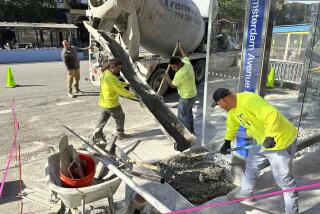Factory orders, home sales highlight sluggish economic recovery
- Share via
Demand for a range of long-lasting U.S. manufactured goods unexpectedly fell last month and a gauge of business spending plans also dropped, underscoring the economic recovery’s tepid pace.
Another report Wednesday from the Commerce Department showed new-home sales continued to bounce along the bottom, leaving intact expectations in financial markets that the Federal Reserve would ease monetary policy further next week.
“You are seeing a convergence in the different sectors of the economy around the slow-growth scenario,” said Zach Pandl, an economist at Nomura Securities International in New York.
Orders for durable goods, excluding transportation, fell 0.8% after rising 1.9% in August as bookings for communications equipment tumbled sharply. Economists, who track this core figure closely, had expected a 0.5% gain.
Overall orders, however, jumped 3.3% — the largest increase since January — lifted by a surge in demand for aircraft. Orders had dropped 1% in August and economists had looked for a 2% increase in September.
The second report showed new-home sales rose 6.6% last month to a still-weak annual rate of 307,000 units.
The number of new homes available for sale last month dropped to a 42-year low of 204,000, the Commerce Department’s report showed. At September’s sales pace, that represents an eight-month supply, down from 8.6 months’ worth in August.
The median sale price for a new home rose 3.3% from September 2009 and 1.5% from August to $223,800, the highest since May.
Business spending, which has been growing strongly, is starting to slow down.
Nondefense orders of capital goods excluding aircraft, a closely watched proxy for business investment, slipped 0.6% in September after a 4.8% increase in August. Analysts had expected a 0.8% gain.
“Overall, these figures suggest that the industrial recovery is nearing an end. Without it, the overall economy is going to struggle,” said Paul Dales, a U.S.-focused economist at Capital Economics in Toronto.
The government is expected to report Friday that the economy expanded at a 2% annual rate in the third quarter, a touch faster than the second quarter’s 1.7% pace but too sluggish to cut into a 9.6% jobless rate.
More to Read
Inside the business of entertainment
The Wide Shot brings you news, analysis and insights on everything from streaming wars to production — and what it all means for the future.
You may occasionally receive promotional content from the Los Angeles Times.








